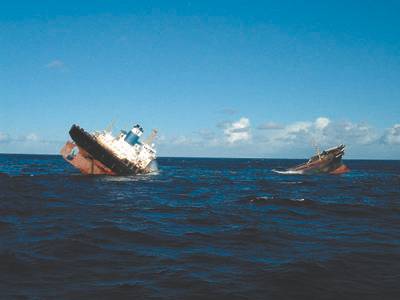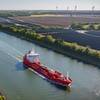Regulation of Ship Design and Construction
It is often said that humans learn more from their failures than from their successes. While the saying may be an exaggeration, there have certainly been a number of failures in the design and construction of ships that have resulted in improvements of future efforts. Some of those improvements have been forced on the marine industry by government regulation. More often, though, government regulation has been utilized to ensure that all players implement needful improvements that have been voluntarily adopted by forward-thinking companies.
An early example of a needful improvement that was made uniform was the Plimsoll mark or load line. In the 1800s, many ships were being overloaded so as to maximize revenue. Overloading led, not unsurprisingly, to ships sinking in weather conditions that should not have been a problem. After several years of advocacy, chiefly by British Member of Parliament Samuel Plimsoll, Parliament enacted the UK Merchant Shipping Act 1876, requiring ships to be surveyed and have marks affixed to the outside of the hull showing the line(s) above which they could not be safely loaded. While many ships were already operating in that manner, the law made the system uniform.
Following the sinking of the TITANIC, the international maritime community developed and adopted the Safety of Life at Sea (SOLAS) Convention. It established uniform standards for, among other things, navigation, construction, radiotelegraphy, and life-saving appliances. Watertight and fire-resistant bulkheads were required. Radio communications capability (at that time, Morse Code) was required on large passenger ships. Lifeboats capable of holding 120% of the persons on board were required. The SOLAS Convention has been renewed, expanded, and amended many times since.
Fire protection standards, particularly on passenger ships, were significantly improved following the fire on the MORRO CASTLE on September 8, 1934, when 137 passengers and crew lost their lives. Investigation revealed that the design of the ship and its use of flammable construction materials were significant contributory factors in the casualty. Wood-lined openings between the ceilings and the steel bulkheads allowed the fire to rapidly spread.
Possibly the most famous (or infamous) example of regulation of ship design was the mandate that new oil tankers have double hulls. The mandate is found in the U.S. Oil Pollution Act of 1990 (OPA 90). The concept, though, was not invented by the U.S. Congress. Ships, admittedly a minority, had been built with double hulls for years. OPA 90 merely made everyone operate at that level. Double hulls for tankers are generally, although not universally, seen as an improvement over single hulls. The major problem with the double hull provision as found in the current version of OPA 90 is that it does not allow for alternatives, regardless of effectiveness. Naval architects and marine engineers are innovative. Given time and incentive, they will develop different designs for tankers that reduce the risk of oil spills more than do double hulls. There is no incentive to do such sophisticated design and testing if there is no market. So long as OPA 90 does not allow use of alternative designs shown to be at least as good as double hulls, the world will be deprived of those improvements.
On March 23, 2006, a fire broke out on a cabin balcony on the cruise ship Star Princess. By the time the fire was extinguished one-and-one-half hours after discovery, one passenger had died of smoke inhalation and another 13 were treated for the effects of smoke. Investigation quickly revealed that the polycarbonate balcony divisions generated intense heat and copious amounts of smoke as they burned. Combustibility of materials used in balcony areas had not been factored, as the balconies were outside standard fire zones for vessels. Similarly, fire detection and suppression equipment was not routinely installed in the balcony areas. The cruise industry immediately adopted voluntary standards to address these shortcomings and the SOLAS Convention was rapidly amended to make those standards uniform and mandatory. On the one hand, the industry (including the architects, engineers, and standard setters) had failed to recognize the problem as cruise ships began to be designed and built with exterior balconies.
On the other hand, the reaction following this casualty was a heartening example of how we can learn from our failures.
When it became apparent that the discharge of oily waste water from ships was creating an environmental problem, engineers developed the oily water separator (OWS). The requirement for ships to install and utilize the OWS was mandated in the International Convention for the Prevention of Pollution from Ships (MARPOL Convention). The design and operation of the OWS has been improved over the years and the MARPOL requirement has generally kept pace with the engineering. Further improvements in the OWS are needed and are being worked on. There is little doubt that the mandates for installation and use of the OWS will be modified to account for those improvements as they come on line.
Specialized container ships are a relatively recent phenomenon. Even more recent are the ultra-large container ships, able to carry in excess of 10,000 TEU (20-foot equivalent units). The January 18, 2007 casualty involving the MSC NAPOLI caused many naval architects and marine engineers to re-examine various assumptions that had gone into the design of container ships. The MSC NAPOLI was large (4,419 TEU capacity) but nowhere near as large on those container ships recently launched or on the drawing boards. Only when the investigation of this casualty (and several others) has been completed and analyzed will the architects and engineers develop appropriate solutions. Once those have been developed, there is little doubt that those solutions will be incorporated into the SOLAS Convention so as to ensure that everyone is operating from the same prospective.
The objective is not uniformity for its own sake. The goal of standard setting and regulation in the maritime industry is to ensure that lessons learned, either though failures (such as the TITANIC or the STAR PRINCESS) or through experimentation and innovation (such as the development of the double hull or the OWS) are implemented across the board, not just by a few forward-thinking companies.
Those involved in standard setting and regulation, though, must exercise care so as to avoid stifling future improvements. The way must be left open for naval architects and marine engineers to do their work.
Dennis L. Bryant, Senior Maritime Counsel at the law firm of Holland & Knight, Washington, D.C., is a contributing editor of MR/EN. For additioal information contact Dennis at [email protected]
(Reprinted from the September edition of Maritime Reporter)











